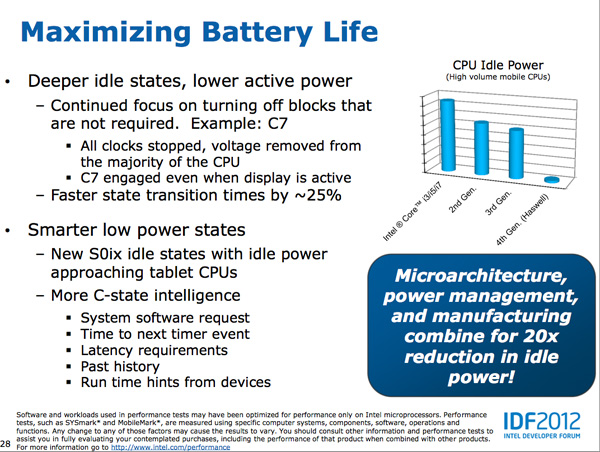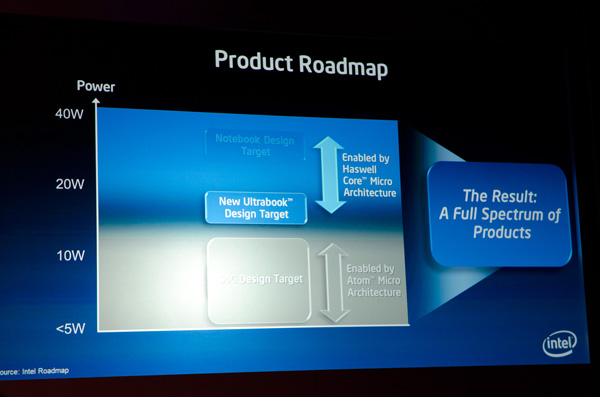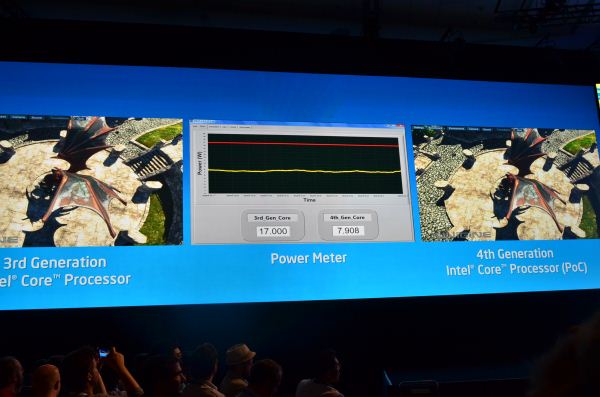Intel's Haswell Architecture Analyzed: Building a New PC and a New Intel
by Anand Lal Shimpi on October 5, 2012 2:45 AM ESTOther Power Savings
Haswell's power savings come from three sources, all of which are equally important. We already went over the most unique: Intel's focus on reducing total platform power consumption by paying attention to everything else on the motherboard (third party controllers, voltage regulation, etc...). The other two sources of power savings are more traditional, but still very significant.

At the micro-architecture level Intel added more power gating and low power modes to Haswell. The additional power gating gives the power control unit (PCU) more fine grained control over shutting off parts of the core that aren't used. Intel published a relatively meaningless graph showing idle power for standard voltage mobile Haswell compared to the previous three generations of Core processors.
Haswell can also transition between power states approximately 25% faster than Ivy Bridge, which lets the PCU be a bit more aggressive in which power state it selects since the penalty of coming out of it is appreciably lower. It's important to put the timing of all of this in perspective. Putting the CPU cores to sleep and removing voltage/power from them even for a matter of milliseconds adds up to the sort of savings necessary to really enable the sort of always-on, always-connected behavior Haswell based systems are expected to deliver.
Intel has also done a lot of work at the process level to bring Haswell's power consumption down. As a tock, Haswell is the second micro-architecture to use Intel's new 22nm tri-gate transistors. The learnings from Ivy Bridge are thus all poured into Haswell. Intel wasn't too specific on what it did on the manufacturing side to help drive power down in Haswell other than to say that a non-insignificant amount of work came from the fabs.
The Fourth Haswell
At Computex Intel's Mooly Eden showed off this slide that positioned Haswell as a 15-20W part, while Atom based SoCs would scale up to 10W and perhaps beyond:
Just before this year's IDF Intel claimed that Haswell ULT would start at 10W, down from 17W in Sandy/Ivy Bridge. Finally, at IDF Intel showed a demo of Haswell running the Unigen Heaven benchmark at under 8W:
The chain of events tells us two things: 1) Intel likes to play its cards close to its chest, and 2) the sub-10W space won't be serviced by Atom exclusively.
Intel said Haswell can scale below 10W, but it didn't provide a lower bound. It's too much to assume Haswell would go into a phone, but once you get to the 8W point and look south you open yourself up to fitting into things the size of a third generation iPad. Move to 14nm, 10nm and beyond then it becomes more feasible that you could fit this class of architecture into something even more portable.
Intel is being very tight lipped about the fourth client Haswell (remember the first three were desktop, mobile and ultra-low-volt/Ultrabook) but it's clear that it has real aspirations to use it in a space traditionally reserved for ARM or Atom SoCs.
One of the first things I ever heard about Haswell was that it was Intel's solution to the ARM problem. I don't believe a 10W notebook is going to do anything to the ARM problem, but a sub-8W Haswell in an iPad 3 form factor could be very compelling. Haswell won't be fanless, but Broadwell (14nm) could be. And that could be a real solution to the ARM problem, at least outside of a phone.
As I said before, I don't see Haswell making it into a phone but that's not to say a future derivative on a lower power process wouldn't.













245 Comments
View All Comments
A5 - Friday, October 5, 2012 - link
8 years is a loooooong time in this space, and yes you (and most people here) are in the minority.Notebooks have been outselling desktops for several years, and in 2011 smartphone shipments were higher than all PC form-factors combined. It's pretty clear where the big bucks are going, and it isn't desktop PCs.
flamethrower - Friday, October 5, 2012 - link
In 8 years you'll have 50-inch OLED TVs on your walls. What's going to drive them? Possibly a computer integrated into them.Peanutsrevenge - Friday, October 5, 2012 - link
We'll just be using large screens, keyboards and mice wireless connected to our ultra portable devices.The desktop will likely still exist for people like us who frequent this site, however it's role will be far more specialised, possibly more as our personal cloud servers than our PCs.
yankeeDDL - Friday, October 5, 2012 - link
Wow. Thanks for the excellent article: I really enjoyed it.The thought of having a processor of the power level of Ivy bridge in my mobile phone blows my mind.
Honestly though, I really can't see how the volume of CPUs for desktop PCs and servers is going to drop so dramatically, that Intel will need the volume generated by mobile, to "survive".
Yes, of course more volume will help, but 8 years from now, even if the mobiles will have such kind of computational power, I would imagine that a Desktop would have 10~20x that performance, as it is today.
It's true that today's CPUs are typically more powerful than the average user ever needs, but raise the hand who wouldn't trade his CPU for one 10x faster (in the same power envelope) ...
That said, 10W still seems like a lot to fit in a mobile: who knows the power consumption of high-end mobile CPUs today? (quad-core Krait CPU, for example, or even Tegra3)
dagamer34 - Friday, October 5, 2012 - link
Intel's real problem is that the power needed for "good enough" computing in a typical desktop CPU came a couple of years ago Nd is rapidly approaching in mobile. With more and more tasks being offloaded to the cloud, battery life is becoming a stronger and stronger focus.What's sad is that because AMD isn't the major player it once was, Intel has allowed it's eye off the ball, revving Atom with only minor tweaks and having a laissez faire approach to GPU performance. It's only been recently when mobile has started to dominate in the minds of consumers and Intel's lack of any major design wins (the RAZR I doesn't count) which has forced Intel to push as hard as it is now.
sp3x0ps - Friday, October 5, 2012 - link
Where is the iPhone 5 review? I need details!! arghh.Demon-Xanth - Friday, October 5, 2012 - link
Atom was targeted to UMPCs, but quickly took over low power embedded systems who don't need much power but do run Windows.tipoo - Friday, October 5, 2012 - link
Poor Via.dgingeri - Friday, October 5, 2012 - link
"Within 8 years many expect all mainstream computing to move to smartphones, or whatever other ultra portable form factor computing device we're carrying around at that point."They said the same thing about laptops. Sure, laptops hold about 60-65% of the market these days, but the desktop is still very much around, and is the preferred platform for PC gamers and HTPC applications. They're far more flexible than any mobile form factor.
Smartphones also have the severe disadvantage of a very small screen. Even the largest are too small for most people to deal with. On top of that, actually surfing the net on those tiny screens is an exercise in frustration for many people. I try to tap on a link, only to get the link next to it, or above it, or below it, or possibly having my stupid phone just select the text instead of following the link.
Smartphones have their niche. There's no doubt there, but they are not going to be anyone's mainstream device unless they have needle thin fingers and 20/10 vision.
Anand Lal Shimpi - Friday, October 5, 2012 - link
I agree with the notebook/desktop comparison - these form factors won't go away. I should have said the majority of mainstream client computing goes to smartphones. And solving the display and input problems is easy: wireless display (WiDi/Miracast) and wireless keyboard/mouse (or a dock that does both over wires if you'd rather that).Take care,
Anand